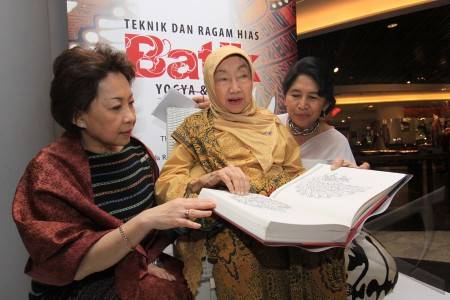
On Thursday, 10 March 2011 Panin Bank and Titian Foundation launched a state of the art book entitled “Teknik dan Ragam Hias Batik Yogya & Solo” in a very Indonesian event at Palalada Restaurant, Grand Indonesia, Jakarta. The book, officially launched by Sri Soedewi Samsi as the author together with Roosniati Salihin of Panin Bank and Lily Kasoem of Titian Foundation, conserves various techniques in batik making, starting from selection of fabrics until dyeing process and diversity of traditional patterns and collections of Yogyakarta and Solo. The aim of publishing this book is to introduce and preserve outstanding cultural heritage of this nation to the young generation in order them to love their own culture.
“Teknik dan Ragam Hias Batik Yogya & Solo” is a ‘one of a kind’ batik book. While majority of batik books showcase finished batik cloth, this book depicts original patterns of traditional batik from the Javanese cultural centers of Yogyakarta and Solo. The book’s writer, Ir. Sri Soedewi Samsi, had been collecting these traditional patterns from villages around these two cities for more than 30 years. During her time as the head of the Department of Research and Development of the Batik and Craft Industry in the 70’s, she traveled from village to village collecting indigenous batik patterns from each one. Most of her discoveries, needless to say, were in the form of batik cloths or shawls. Under her intensive supervision and guidance, a professional batik artist was commissioned to redraw them into a ready-to-use patterns.
Consisting of nearly 600 pages, the book has two sections. In the first section, Ibu Dewi describes the technical aspects of batik and the batik making process, from the equipment, colouring methods and chemical components. There is also a brief history of batik. The second section, which forms the main body of book, depicts nearly 400 traditional batik patterns found around Yogyakarta and Solo. Ibu Dewi has carefully selected them and grouped them into two main categories: geometric and non-geometric patterns. All patterns are drawn to actual size so that batik artists can apply them directly to a white fabric to start making batik.

